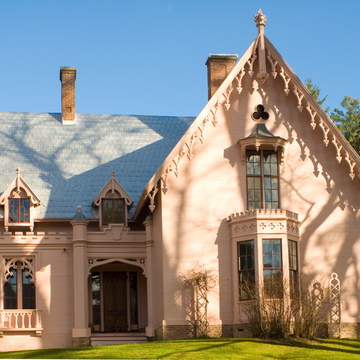One of the most famous Gothic Revival houses in America, Justin Morrill's villa at the edge of Strafford village is a highly personal embodiment of the ideas of Andrew Jackson Downing. A blacksmith's son who became a prosperous store owner, by 1848 Morrill had traded commerce for family, farming, and reading in fulfillment of what Downing would soon describe in The Architecture of Country Houses (1850) as the “life of a cultivated mind in the country.” By the time of his marriage in 1851, Morrill had completed an asymmetrically massed one-and-a-half-story, flush-boarded house with a battlemented Tudor-arched entrance porch, trefoil windows, elaborately decorative bargeboards, carved finials, diamond-paned sidelights, and carved mahogany interior woodwork. The design draws on the published work of Downing and of A. J. Davis in its general massing and many details. The color scheme and landscaping also reflect the Downing and Davis approach: the house is painted a pinkish fawn and set in a picturesque landscape that includes a vertical flush-boarded fence with a quatrefoil-decorated gate, curving paths, and small outbuildings. Morrill's original site plan is preserved in the library of the University of Vermont.
Morrill was not long destined to lead the contemplative life for which he built. He entered local and then national politics, serving as a U.S. representative from 1854 to 1866 and then as a U.S. senator until his death in 1898. Nicknamed the “Gladstone of America,” he fought slavery, specialized in tariffs and finance, and also legislated on issues related to agriculture, education, and building. He was the author of the Morrill Acts of 1862 and 1890 in support of land-grant colleges. As chair of the Senate Committee on Buildings and Grounds, he oversaw the planning and execution of the terrace, fountains, and gardens of the U.S. Capitol, completion of the Washington Monument, and construction of the Library of Congress. Though Washington was his primary residence, he continued to embellish his Strafford retreat. He added hoods above his second-floor windows, enclosed the entrance porch to create china cupboards, and added a library wing to the southeast. The house remained essentially unaltered and in family hands until the 1940s. Conserved by subsequent owners, it was named a National Historic Landmark in 1960 and became a State Historic Site in 1969. It is open to the public seasonally.


